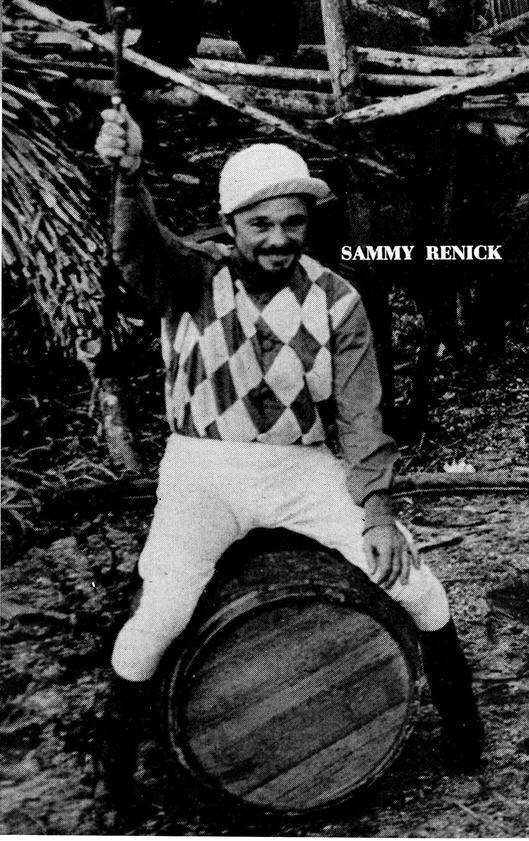
| More than a half century ago, three riders -- Sammy Renick,
Eddie Arcaro, and Johnny Longden -- cared enough about
conditions they and other jockeys endured to pool their money to
form an organization to ensure change. They kicked in $5,000 each to
found the Jockeys' Guild.
Jockeys had long suffered inadequate facilities and were without basic and proper medical attention. The impetus, however, came one hot, humid July day at the old Jamaica (N. Y.) Racetrack. Renick still recalls what happened: "The horse I was riding in the last race stumbled badly leaving the starting gate and went down. I came off, flipped and hit the ground hard. I was in severe pain and needed quick medical attention." But there was neither ambulance nor medical personnel on site. It was the assistant starters who attended Renick. "They picked me up and carefully placed me on a long seat in the back of an old truck. They elevated my leg in an outward position and drove to the hospital -- a painful, 30 minute ride." A few weeks later the Jockeys' Guild was formed and, in 1941, had successfully negotiated an insurance policy with Lloyds of London. Ironically, the day the policy became effective, a young apprentice rider, Joe Giangaspro, was involved in a horrible spill when his mount clipped heels with the horse in front. Giangaspro lost his balance and fell in the path of horses wearing aluminum shoes that kicked and trampled him. He was killed. Conditions for riders improved slowly, but it was not until neatly a decade and a half later the Jockeys' Guild began to see real change. Bert Thompson had become the organization's national manager and had turned his attention to safety standards. He was responsible in insuring an ambulance on the track at all times. And he insisted management set up first aid rooms. One of Thompson's biggest accomplishments was working with an Inglewood, CA, inventor named Welsh and, with backing from John Alessio, President of Caliente Race Track in Tiajuana, Mexico, to create the Caliente Safety Helmet. The November 1956 issue of the Jockey News (the Guild's magazine) reports that 10 leading riders at Belmont Park had tested the Caliente Safety Helmet during the races October 1 and that the National Board of Directors approved the helmet. The article further noted the helmet was in full production and the price was $27.50. Safety rails are another focal point in the Guild's continuing efforts for greater track safety. Unfortunately, tract managements are slow to respond to the need for replacing PVC pipes with modern, safety rails. I cannot help but point to the contrast of two separate incidents. Before Del Mar installed its safety rail, a horse Guild Director Gary Stevens was riding fell into the PVC rail, shattering it. A piece of rail hit Stevens in the forehead, leaving a round indentation the exact diameter of the pipe. Compare that to what happened to another Guild Director, Dean Kutz, at Oaklawn Park when his mount flipped, throwing itself and its rider onto the safety rail, both bounced, but both walked away with only a few bruises. Drug and alcohol-free riding is an another ongoing safety issue. I am very proud that, at its annual meeting in December, 1989, the Jockeys' Guild was the first industry organization to pass a resolution demanding jockeys be prohibited from racing if they are under the influence of drugs and/or alcohol. Another safety issue that has recently come to the fore is the use of flak jackets. Director Jeff Lloyd, who nearly lost his life last fall when a horse left its hoof print embedded in the middle of his back, cites the case of a fellow rider who was wearing a flak jacket and escaped with minor bruising from a similar incident. At the urging of Jockeys' Guild President Jerry Bailey who has been racing with one for the past year, the Jockeys' Guild unanimously adopted a resolution at its 1992 annual meeting endorsing the mandatory use of safety vests, aka flak jackets, by all riders at recognized race tracts in the United States. We are very proud the continued pursuit of safety by the Jockeys' Guild is paying off. In 1992, for the first time in many years, there was not a single death of a jockey on the racetrack. While our efforts for improved safety standards are directed toward professional jockeys at pari-mutuel racetracks, I feel they are applicable to everyone whoever climbs aboard a horse, be it for a canter across a pasture, a trail ride or to follow the hounds. Helmets and flak jackets, particularly, should be compulsory: after all, lives depend upon them. John Giovanni
|